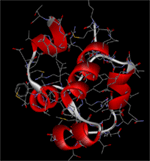


|
|
 |
| SCORING FUNCTION FOR PROTEIN STRUCTURE EVALUATION ProSEE (Protein Structure Energy Evaluation) |
|
|
Protein structure prediction attempts via comparative modeling or ab initio approaches involve generating various three dimensional atomic level models/conformations for the protein sequence, followed by their rapid assay for locating the most preferred native-like conformation characterized by the minimum most free energy. This is accomplished via all-atom energy based empirical scoring functions relating to the conformational free energy of a protein. Balancing simplicity and speed as well as maintaining accuracy in the scoring functions are two important aspects in this effort. Devising a scoring function that can mimic a free energy function and can distinguish between correct (native or native-like) structures from incorrect ones is a challenging task. This has resulted in intense efforts to devise newer, better and more efficient scoring functions. Scoring functions can be either knowledge/statistics based or physics based or can be hybrids of both. Knowledge based scoring functions are derived from experimentally known protein structures, limited only by the training data set. On the other hand physics based scoring functions are force field derived for modelling the energy landscape of the protein. Over the past few years,there is a continuous progression in the ability of empirical potential functions and protocols in pinning down the native as the lowest energy structure, yet design of an energy function which shows 100% discrimination between the native and the decoys is not achieved. |
|
|
Our group at IIT Delhi, has devised an all-atom empirical energy function which combines second generation force field parameters with a hydrophobicity function.
The scoring function considers the non-bonded energy of a protein, expressed as a sum of three terms - electrostatics, van der Waals and hydrophobicity.
ETotal = ∑( Eel + Evdw + Ehpb )
Eel is the electrostatic contribution to the energy, Evdw is the van der Waals term, Ehpb is the hydrophobic contribution and the summation runs over all the atoms of the protein [1-4].
|
 |
| SCORING FUNCTION |